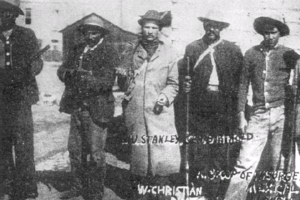Capture of Mexicali facts for kids
Quick facts for kids Capture of Mexicali |
|||||||
|---|---|---|---|---|---|---|---|
| Part of the Mexican Revolution | |||||||
 Simon Berthold (center) and other Magonistas after capturing Mexicali. |
|||||||
|
|||||||
| Belligerents | |||||||
|
|
|
||||||
| Commanders and leaders | |||||||
| Unknown | |||||||
| Strength | |||||||
| 18 infantry | 10 policemen | ||||||
| Casualties and losses | |||||||
| None | 1 killed 12 captured |
||||||
The Capture of Mexicali was an important event at the start of the Mexican Revolution. It was the first time a group of rebels, called Magonistas, fought against the Mexican government led by Porfirio Díaz. These rebels, following the ideas of Ricardo Flores Magón, took control of the border town of Mexicali with very little fighting.
Contents
Why Mexicali Was Important
The Magonistas' Plan
Ricardo Flores Magón and his brother Enrique were strong opponents of the government. They believed in a fairer society where everyone had equal chances. Ricardo was the leader of the Partido Liberal Mexicano (PLM) in Los Angeles. In early 1911, many parts of Mexico were rebelling against the government.
The PLM leaders in California decided to start their own uprising. They chose the small town of Mexicali because it was right on the border. This location was perfect for them. It would make it easier to get supplies and to find volunteers, including people from the United States.
Choosing the Leaders and Location
The PLM leaders picked José María Leyva, a skilled worker who made and repaired guns, to lead their small army. He had 17 other men with him. Leyva was a strong protester against the government. He had even been part of a big workers' strike in 1906.
Simon Berthold, who was part Mexican and part German, was Leyva's second-in-command. Mexicali was also chosen because it was far from Mexico City. This meant it was a long way from where most of the government's soldiers were. The Magonistas also hoped to take the money that Mexican customs agents collected in the town.
How Mexicali Was Captured
The Attack Begins
On January 29, 1911, at dawn, the eighteen Magonistas led by Leyva crossed the border into California. There, just across the line, they found a hidden supply of weapons. They quickly armed themselves with about sixty rifles, some pistols, and thousands of bullets.
After getting their weapons, they went back across the border to the edge of Mexicali. They split into three small groups. The rebels got their weapons ready and then attacked the town.
Taking Key Buildings
The first group, led by Simon Berthold, quickly entered the customs house. They surprised and captured the two officers who were sleeping there. The second group headed for the home of the chief of police. They quickly took control of the building and captured the chief.
The third group, led by José Leyva, attacked the jail. This was where the only shot of the entire event was fired. The jailer, Jose Villanova, refused to give the rebels the keys to the jail cells. He was shot and killed after he tried to get his own pistol. The Magonistas heard him and fired into his office. Ten Mexican policemen were captured at the jail. Villanova was the only person who died during the capture. After the jail was taken, the fighting was over. The prisoners were set free, and nine of them decided to join the Magonistas.
What Happened Next
After the Capture
The two customs officers who were captured paid the Magonistas $385 for their freedom. They were then released and went into California. Of the ten policemen who were captured, seven were set free. They quickly ran across the border into California.
After the Magonistas took Mexicali, their group grew very quickly. It went from just eighteen men to almost 500. About 100 of these new members were Americans. This included famous labor activists like Frank Little and Joe Hill.
The Campaign Continues
The capture of Mexicali marked the beginning of the Magonista Campaign. From Mexicali, the rebels continued their fight. They marched on and later captured Tijuana on May 9. However, they were eventually defeated in another battle just south of Tijuana.
After this defeat, the rebels no longer held any territory. Many of them broke up their groups or escaped back into California.
Images for kids


